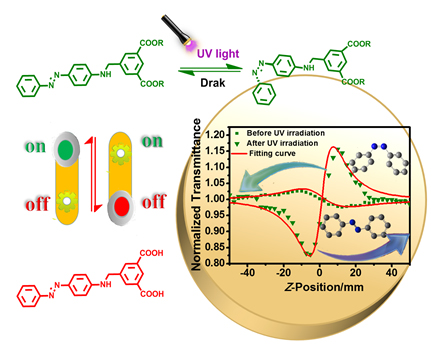[1] Delaire, A. J.; Nakatani, K. Chem. Rev. 2000, 100, 1817.
[2] Green, K. A.; Cifuentes, M. P.; Corkery, T. C.; Samoc, M.; Humphrey, M. G. Angew. Chem., Int. Ed. 2009, 48, 7867.
[3] Castet, F.; Rodriguez, V.; Pozzo, J. L.; Ducasse, L.; Plaquet, A.; Champagne, B. Acc. Chem. Res. 2013, 46, 2656.
[4] Xu, W. J.; Shao, Z. C.; Han. Y. B.; Wang, W.; Song, Y. L.; Hou, H. W. Dyes Pigm. 2018, 152, 171.
[5] Green, K. A.; Cifuentes, M. P.; Samoc, M.; Humphrey, M. G. Coord. Chem. Rev. 2011, 255, 2530.
[6] Champagne, B.; Plaquet, A.; Pozzo, J. L.; Rodriguez, V.; Castet, F. J. Am. Chem. Soc. 2012, 134, 8101.
[7] Feng, Q.; Li, Y. Y.; Shi, G.; Wang, L. L.; Zhang, W. J.; Li, K.; Hou, H. W.; Song, Y. L. J. Mater. Chem. C 2016, 4, 8552.
[8] Beaujean, P.; Bondu, F.; Plaquet, A.; Garcia-Amorós, J.; Cusido, J.; Raymo, F. M.; Castet, F.; Rodriguez, V.; Champagne, B. J. Am. Chem. Soc. 2016, 138, 5052.
[9] Boixel, J.; Guerchais, V.; Bozec, H. L.; Chantzis, A.; Jacquemin, D.; Colombo, A.; Dragonetti, C.; Marinotto, D.; Roberto, D. Chem. Commun. 2015, 51, 7805.
[10] Dhammika Bandara, H. M.; Burdette, S. C. Chem. Soc. Rev. 2012, 41, 1809.
[11] Chu, Z.; Han, Y.; Bian, T.; De, S.; Král, P.; Klajn, R. J. Am. Chem. Soc. 2019, 141, 1949.
[12] Natali, M.; Giordani, S. Chem. Soc. Rev. 2012, 41, 4010.
[13] Zakrevskyy, Y.; Richter, M.; Zakrevska, S.; Lomadze, N.; von Klitzing, R. Adv. Funct. Mater. 2012, 22, 5000.
[14] Chen, L.; Tang, X.; Jia, K.; Tang, X. Z. Chin. J. Org. Chem. 2016, 36, 2197. (陈垒, 唐翔, 贾坤, 唐先忠, 有机化学, 2016, 36, 2197.)
[15] Xu, W. J.; Wang, W.; Li, J. X.; Wu, Q.; Zhao, Y. J.; Hou, H. W.; Song, Y. L. Dyes Pigm. 2019, 160, 1
[16] Chen, L.; Bo, S. H.; He, Y. L.; Chen, Z.; Liu, X. H.; Zhen, Z. Chin. J. Org. Chem. 2017, 37, 2263. (陈璐, 薄淑晖, 和延岭, 陈卓, 刘新厚, 甄珍, 有机化学, 2017, 37, 2263.)
[17] Qu, M.; Liu, M. M.; Liu, J.; Zhang, X. M. Chin. J. Chem. 2014, 32, 1259.
[18] Xie, Q.; Shao, Z. C.; Zhao, Y. J.; Yang, L. P.; Wu, Q.; Xu, W. J.; Li, K.; Song, Y. L.; Hou, H. W. Dyes Pigm. 2019, 170, 107599.
[19] Li, Q. Y.; Chi, Z.; Li, T. F.; Ran, X.; Guo, L. J. Opt. Express 2017, 25, 11503.
[20] Liaros, N.; Couris, S.; Maggini, L.; Leo, F. D.; Cattaruzza, F.; Aurisicchio, C.; Bonifazi, D. ChemPhysChem 2013, 14, 2961.
[21] Szymański, W.; Beierle, J. M.; Kistemaker, H. A. V.; Velema, W. A.; Feringa, B. L. Chem. Rev. 2013, 113, 6114.
[22] Xue, X. N.; Wang, H. R.; Han, Y. B.; Hou, H. W. Dalton Trans 2018, 47, 13.
[23] Lovrien, R.; Pesheck, P.; Tisel, W. J. Am. Chem. Soc. 1974, 96, 244.
[24] Klotz, I. M.; Fiess, H. A.; Chen Ho, J. Y.; Mellody, M. J. Am. Chem. Soc. 1954, 76, 5136.
[25] Nihei, M.; Kurihara, M.; Mizutani, J.; Nishihara, H. J. Am. Chem. Soc. 2003, 125, 2964.
[26] Beharry, A. A.; Woolley, G. A. Chem. Soc. Rev. 2011, 40, 4422.
[27] Wu, Z.; Xue, R.; Xie, M.; Wang, X.; Liu, Z.; Drechsler, M.; Huang, J.; Yan, Y. J. Phys. Chem. Lett. 2018, 9, 163.
[28] Joshi, N. K.; Fuyuki, M.; Wada, A. J. Phys. Chem. B 2014, 118, 1891.
[29] Wettermark, G.; Langmuir, M. E.; Anderson, D. G. J. Am. Chem. Soc. 1965, 87, 476.
[30] Beharry, A. A.; Sadovski, O.; Woolley, G. A. J. Am. Chem. Soc. 2011, 133, 19684.
[31] Zhou, H.; Xue, C.; Weis, P.; Suzuki, Y.; Huang, S.; Koynov, K.; Auernhammer, G. K.; Berger, R.; Butt, H. J.; Wu, S. Nat. Chem. 2017, 9, 145.
[32] Zhang, W.; He, C. Y.; Xiao, X. W.; Song W. N.; Gao, Y. C.; Chen, Z. M.; Dong, Y. L.; Wu, Y. Q.; Wang, Q. Chin. J. Chem. 2016, 34, 1006.
[33] Liang, P. X.; Mi, Y. S.; Duan, J. S.; Yang, Z.; Wang, D.; Cao, H.; He, W. L.; Yang, H. Chin. J. Chem. 2016, 34, 381.
[34] Niu, R. J.; Zhou, W. F.; Liu, Y.; Yang, J. Y.; Zhang, W. H.; Lang, J. P.; Young, D. J. Chem. Commun. 2019, 55, 4873.
[35] Zhang, C.; Song, Y. L.; Wang, X. Coord. Chem. Rev. 2007, 251, 111.
[36] Chen, Q. F.; Zhao, X.; Liu, Q.; Jia, J. D.; Qiu, X. T.; Song, Y. L.; Young, D. J.; Zhang, W. H.; Lang, J. P. Inorg. Chem. 2017, 56, 5669.
[37] Zhao, Y. J.; Li, H. H.; Shao, Z. C.; Xu, W. J.; Meng, X. R.; Song, Y. L.; Hou, H. W. Inorg. Chem. 2019, 58, 4792.
[38] Li, J. L.; Ding, G. H.; Niu, Y. Y.; Wu, L. Y.; Duan, H. Y.; Feng, F. J.; He, W. J. Chin. J. Org. Chem. 2018, 38, 931. (李建玲, 丁国华, 牛燕燕, 吴禄勇, 段红叶, 冯华杰, 何文英, 有机化学, 2018, 38, 931.)
[39] Wu, X. Z.; Xiao, J. C.; Sun, R.; Jin, T. X.; Yang, J. Y.; Shi, G.; Wang, Y. X.; Zhang, X. R.; Song, Y. L. Adv. Opt. Mater. 2017, 5, 1600712.
[40] Hou, H. W.; Wei, Y. L.; Song, Y. L.; Mi, L. W.; Tang, M. S.; Li, L. K.; Fan, Y. T. Angew. Chem., Int. Ed. 2005, 44, 6067.
[41] Liang, P. X.; Li, Z. Q.; Mi, Y. S.; Yang, Z.; Wang, D.; Cao, H.; He, W. L.; Yang, H. J. Electron. Mater. 2015, 44, 2883.
[42] Xiao, Z. G.; Shi, Y. F.; Sun, R.; Ge, J. F.; Li, Z. G.; Fang, Y.; Wu, X. Z.; Yang, J. Y.; Zhao, M. G.; Song, Y. L. J. Mater. Chem. C 2016, 4, 4647.
[43] Kanoo, P.; Matsuda, R.; Sato, H.; Li, L.; Jeon, H. J.; Kitagawa, S. Inorg. Chem. 2013, 52, 10735. |
